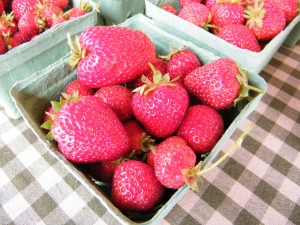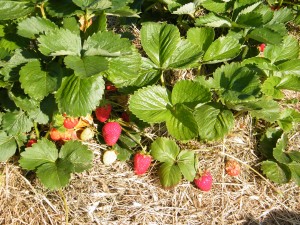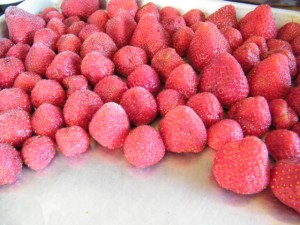Like all fruits and vegetables, there are many, many different kinds of strawberries. Two categories of strawberries are “June-bearing” and “ever-bearing.” June-bearers are more common in the Cowichan Valley: they produce heavily in June/July, then focus on reproducing through runners for the rest of the summer. We prefer to grow ever-bearers, because production is spread out over the season, which spreads out the work of harvesting them over the season. This makes them more manageable and gives us a yummy berry fruit to offer to our customers from July through September. We also find that ever-bearers taste better.
Within these categories there are many different varieties, with a range of sizes, shapes, and degrees of sweet-tart flavour. At one point we grew 15 different varieties, but now have our favourites: some berries are large, some tiny; some keep for only 24 hours after picking, others for longer; some taste jam-sweet and others have more complex flavours.
Attention Germaphobes
 Strawberries should never be washed. They absorb the water, so you’re eating watery berries. We find they taste like weak Kool Aid. Ew! This is why we don’t pick or sell strawberries after a big rain storm. They simply don’t taste good enough. (And picking strawberries when the leaves are wet spreads diseases, which is not good for our patch.) Not being able to wash strawberries is just another reason to only buy organically-grown berries.
Strawberries should never be washed. They absorb the water, so you’re eating watery berries. We find they taste like weak Kool Aid. Ew! This is why we don’t pick or sell strawberries after a big rain storm. They simply don’t taste good enough. (And picking strawberries when the leaves are wet spreads diseases, which is not good for our patch.) Not being able to wash strawberries is just another reason to only buy organically-grown berries.
How to Freeze Strawberries
Our preferred way to preserve our harvest (aside from making strawberry jam) is to freeze the berries. We can then use our frozen supply for strawberry daiquiris, pies and jam all winter.
-
Cut off the tops of the berries (the green stem part).
- Place berries on a cookie sheet in a single layer.
- Put the cookie sheet and berries into the freezer for an hour or two.
- Move frozen berries into a sealable, freezable container (e.g. Ziplock bag, glass jar) and into the freezer until you’re ready to use them.
This way the berries freeze singly and not into a big mass, so you can use as many or as few as you need each time.
Farmer Brock’s Strawberry Daiquiries
A few summers ago I realized that – what a coincidence – we grow strawberries, and Brock’s favourite alocholic beverage happens to be a strawberry daiquiri. (Brock is known at the Craig Street Brew Pub as the dude who orders strawberry daiquiris.) I ran out to Brock in the field to share my epiphany, and we booted it to the liquor store to get rum. After many attempts over the years, this is the best and easiest strawberry daiquiri recipe we’ve found. After a hot day of weeding the strawberry patch yet again, a round of daiquiris makes everyone feel better.
In a blender, blend:
1/4 cup lemon juice (or 1/8 cup lime juice and 1/2 cup lemon juice)
1/2 cup sugar
(This breaks down the sugar crystals.)
Then add at least 2 cups (1 pint) strawberries
3/4 cup rum
and blend to make your concentrate.
Then add 6 cups of ice and blend to make daiquiris.
Serve with a straw.


